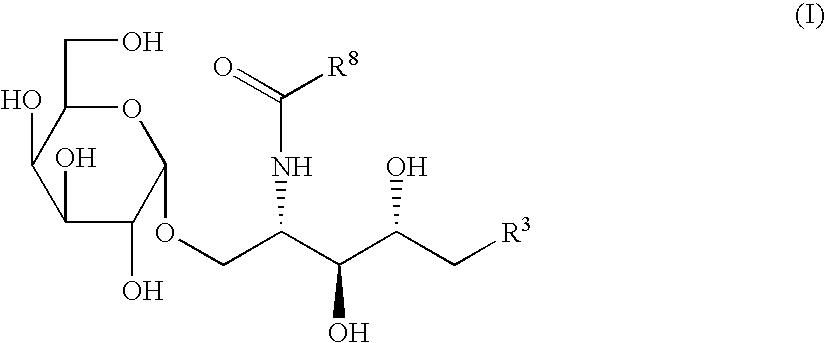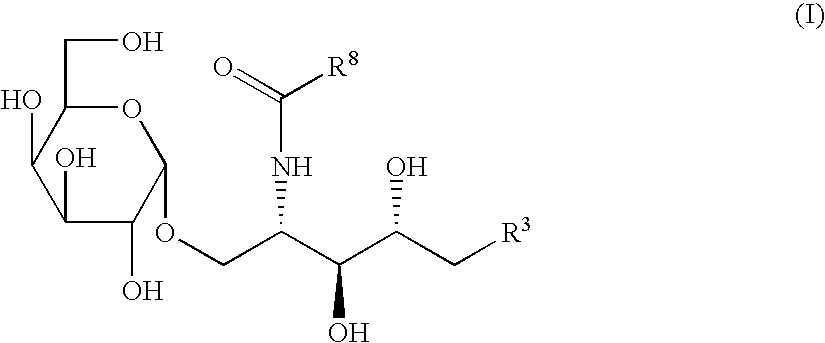Glycolipids and synthetic method thereof as well as their synthetic intermediates, and synthetic intermediates, and synthetic method thereof
a glycolipid and synthetic method technology, applied in the field of new glycolipid derivatives and their synthetic methods, can solve the problems of low yield, systemic side effects, and clinical application of itself being substantially impossible, and achieve low yield
- Summary
- Abstract
- Description
- Claims
- Application Information
AI Technical Summary
Benefits of technology
Problems solved by technology
Method used
Image
Examples
reference example 1
Synthesis of 1,3-O-benzylidene-5-O-[(4-methylphenyl)sulfonyl]-D-arabitol (Compound 1)
[0090]To 1,3-O-benzylidene-D-arabitol able to be synthesized from D-arabitol and benzaldehyde (R. Wild et al., Liebigs Ann. Org. Bioorg. Chem. 1995, 5, 755-764) (34.0 g, 141 mmol) in a methylene chloride (1.2 L) suspension, under ice cooling, dibutyl tin oxide (702 mg, 2.82 mmol) and p-toluene sulfonyl chloride (27.0 g, 141 mmol) were added in small amounts at a time. Further, triethylamine (19.7 ml, 141 mmol) was added. The mixture was stirred at 0° C. to room temperature for 21 hours. The reaction mixture was concentrated, then the residue obtained was purified by silica gel column chromatography (methylene chloride:methanol=20:1) to obtain the above-referenced compound in an amount of 55.3 g (yield 99%).
reference example 2
Synthesis of 4,5-anhydro-1,3-O-benzylidene-D-arabitol (Compound 2)
[0091]To the compound 1 synthesized in Reference Example 1 (51.1 g, 130 mmol) in a dehydrated tetrahydrofuran (800 ml) solution, under ice cooling, potassium t-butoxide (18.1 g, 161 mmol) was added. The resultant mixture was stirred at 0° C. to room temperature for 38 hours. Water was added to the reaction mixture, then the product was extracted with ethyl acetate (3 times) and washed with brine. The organic layer was dried with sodium sulfate, then filtered and concentrated in vacuo. The residue obtained was purified by silica gel column chromatography (n-hexane:ethyl acetate=1:l) to obtain the above-referenced compound in an amount of 26.2 g (yield 92%).
example 1
Synthesis of 1,3-O-benzylidene-D-arabino-1,2,3,4-nonanetetraol (Compound 3)
[0092]To copper (I) iodide (42.9 g, 225 mmol) in a dehydrated tetrahydrofuran (560 ml) suspension, 2.64M n-butyl lithium / n-hexane solution (341 ml, 900 mmol) was dropwise added at −40° C. and the mixture stirred at −30° C. to −10° C. for 30 minutes to 2 hours. Next, the compound 2 synthesized as shown in Example 2 (50.0 g, 225 mmol) in a dehydrated tetrahydrofuran (400 ml) solution was dropwise added at −40° C. and the resultant mixture stirred at −30° C. to −20° C. for about 3 hours. A saturated ammonium chloride aqueous solution was added to the reaction mixture, the product was extracted with ethyl acetate, and the organic layer was washed with brine, dried with magnesium sulfate, filtered, then concentrated in vacuo to obtain the above-referenced compound 58.4 g (yield 93%).
PUM
| Property | Measurement | Unit |
|---|---|---|
| temperature | aaaaa | aaaaa |
| temperature | aaaaa | aaaaa |
| melting point | aaaaa | aaaaa |
Abstract
Description
Claims
Application Information
 Login to View More
Login to View More - R&D
- Intellectual Property
- Life Sciences
- Materials
- Tech Scout
- Unparalleled Data Quality
- Higher Quality Content
- 60% Fewer Hallucinations
Browse by: Latest US Patents, China's latest patents, Technical Efficacy Thesaurus, Application Domain, Technology Topic, Popular Technical Reports.
© 2025 PatSnap. All rights reserved.Legal|Privacy policy|Modern Slavery Act Transparency Statement|Sitemap|About US| Contact US: help@patsnap.com



